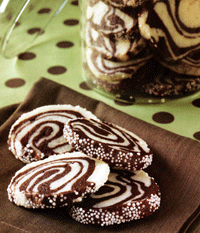 |
|||||
|
|
|
|
|
|
|
Chocolate-Vanilla Swirl Cookiesfrom Baking for All Occasions by Flo Braker |
||||

Vanilla Dough:
2-3/4 cups cake flour1 cup plus 2 tablespoons powdered sugar 1/4 teaspoon salt 8 ounces unsalted butter, softened 1 teaspoon pure vanilla extract Chocolate Dough
2-1/4 cups cake flour1 cup plus 2 tablespoons powdered sugar 1/2 cup plus 1 tablespoon unsweetened natural Dutch-processed cocoa powder 1/4 teaspoon salt 8 ounces unsalted butter, softened 1 teaspoon pure vanilla extract 2 cups nonpareil sprinkles for decoration Makes 6
This and many other wonderful recipes may be found in Baking for All Occasions
by Flo Braker from Chronicle Books
|
The first word that came to mind when I saw these intricately swirled cookies was Rorschach: every one expresses something different, just like the famous inkblot test. The recipe is from my talented dear friend Nora Tong, owner of Nora's Patisserie in Daly City, California, about six miles south of San Francisco. She uses a special method of stretching and twisting the dough into two-tone logs, so that when the cookies are sliced, each is a unique work of art. For seasonal variations, customize the sugar coating on the outside of the logs, from red and green for Christmastime to spooky black and orange for Halloween. I always have one or two of these dough logs on hand in my refrigerator or freezer so I can slice and bake on demand. This recipe exemplifies how weighing ingredients is more accurate than measuring by volume. For example, if you measure different brands of cocoa powder in a cup measure and then put them on a scale, you will discover they weigh differently. But if you use weight as your measuring method, you will always end up with the same amount of each ingredient and your cookies will always have the optimum amount of chocolate flavor.
To make the Vanilla Dough:
To make the Chocolate Dough:
To form into logs:
To marble the logs: Spread the nonpareil sprinkles in a large rectangular pan, such as a 9 x 13 x 2-inch pan (quarter sheet pan). One at a time, roll each dough log back and forth in the sprinkles to coat the outside of the log evenly. Set the coated logs on a baking sheet and refrigerate until firm enough to handle without disturbing the shape, about 1 hour. Then wrap in plastic wrap and return to the refrigerator until firm, 1 to 1-1/2 hours longer. For longer storage, overwrap with aluminum foil, label with the contents and date, and freeze for up to 1 month. Thaw in the refrigerator for several hours or up to overnight before baking.
Before baking: Using a sharp knife, cut 1 or more chilled logs into 1/4-inch-thick slices and arrange the slices on the prepared baking sheets, spacing them 1/2 inch apart. Bake the cookies, 1 sheet at a time, just until they are no longer shiny on top and are lightly golden on the bottom, 10 to 12 minutes. Don't let them color on top. Using a metal spatula, transfer the cookies to wire racks and let cool completely. Stack the cooled cookies in an airtight container and store at room temperature for up to 10 days. |
|||
|
Copyright © 2009 Epicurean.com & Chronicle Books All rights reserved |
|
|
